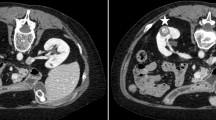Abstract
Purpose
To assess the impact of HA on robotic PN (RPN) outcomes.
Methods
We retrospectively analyzed data from patients who underwent RPN in eight centers between 2009 and 2013. Hemorrhagic complications were defined as the occurrence of a pseudoaneurysm, arteriovenous fistula or hematoma requiring transfusion. Patients were first divided into two groups: group A (use of at least one HA) and group B (no HA used), and then into five groups to assess the impact of each HA: group 1 (no HA), group 2 (Floseal® only), group 3 (Surgicel® only), group 4 (Tachosil® only) and group 5 (Surgicel® + Floseal®). The impact of HA was evaluated by univariate and multivariate analysis.
Results
Out of 515 RPN, 315 (61 %) were done using at least one HA (group A) and 200 (39 %) were done without any HA (group B). Patients in both groups had similar hemorrhagic complication rates (13 % vs. 15 %, p = 0.42) and postoperative complication rates (19 % vs. 23 %, p = 0.32). In multivariate analysis, the absence of HA was not a risk factor for hemorrhagic complications (OR 0.77, p = 0.54). When each type of HA was considered individually, none was associated with the occurrence of hemorrhagic complication either in univariate or in multivariate analysis.
Conclusion
In this multicenter study, the use of HA was not associated with a lower risk of hemorrhagic or global complications.
Similar content being viewed by others
References
Ljungberg B, Bensalah K, Bex A et al. Guidelines on renal cell carcinoma. Uroweb 2013. http://www.uroweb.org/gls/pdf/10_Renal_Cell_Carcinoma_LRV2.pdf
Gill IS, Kavoussi LR, Lane BR et al (2007) Comparison of 1800 laparoscopic and open partial nephrectomies for single renal tumors. J Urol 178:41–46
Achneck HE, Sileshi B, Jamiolkowski RM et al (2010) A comprehensive review of topical hemostatic agents: efficacy and recommendations for use. Ann Surg 251:217–228
Dalpiaz O, Neururer R, Bartsch G et al (2008) Haemostatic sealants in nephron-sparing surgery: what surgeons need to know. BJU Int 102(11):1502–1508
Lang H, Mouracade P, Gimel P et al (2014) National prospective study on the use of local haemostatic agents during partial nephrectomy. BJU Int 113(5b):E56–E61
Gill IS, Ramani AP, Spaliviero M et al (2005) Improved hemostasis during laparoscopic partial nephrectomy using gelatin matrix thrombin sealant. Urology 65(3):463–466
Breda A, Stepanian SV, Lam JS et al (2007) Use of haemostatic agents and glues during laparoscopic partial nephrectomy: a multi-institutional survey from the United States and Europe of 1347 cases. Eur Urol 52(3):798–803
Porpiglia F, Renard J, Billia M et al (2007) Biological glues and collagen fleece for hemostasis during laparoscopic partial nephrectomy: technique and results of prospective study. J Endourol 21(4):423–428
Ficarra V, Rossanese M, Gnech M, Novara G, Mottrie A (2014) Outcomes and limitations of robotic and laparoscopic partial nephrectomy. Curr Opin Urol 24(5):441–447
Benway BM, Wang AJ, Cabello JM, Bhayani SB (2009) Robotic partial nephrectomy with sliding clip renorrhaphy: technique and outcomes. Eur Urol 55(3):592–599
Orvieto MA, Chien GW, Laven BA et al (2004) Eliminating knot tying during warm ischemia time for laparoscopic partial nephrectomy. J Urol 2004(172):2292–2295
Cohen J, Jayram G, Mullins JK, Allaf ME (2013) Do fibrin sealants impact negative outcomes after robot-assisted partial nephrectomy? J Endourol 27(10):1236–1239
Dindo D, Demartines N, Clavien PA (2004) Classification of surgical complications: a new proposal with evaluation in a cohort of 6336 patients and results of a survey. Ann Surg 240(2):205–213
Kim JH, Park YH, Kim YJ, et al. (2015) Perioperative and long-term renal functional outcomes of robotic versus laparoscopic partial nephrectomy: a multicenter matched-pair comparison. World J Urol. PMID:25585500 [Epub ahead of print]
Ramani AP, Desai MM, Steinberg AP et al (2005) Complications of laparoscopic partial nephrectomy in 200 cases. J Urol 173(1):42–47
Van Dijk JH, Pes PL (2007) Haemostasis in laparoscopic partial nephrectomy: current status. Minim Invasive Ther Allied Technol 16:31–44
Aboumarzouk OM, Stein RJ, Eyraud R et al (2012) Robotic versus laparoscopic partial nephrectomy: a systematic review and meta-analysis. Eur Urol 62(6):1023–1033
Peyronnet B, Baumert H, Mathieu R et al (2014) Early unclamping technique during robot-assisted laparoscopic partial nephrectomy can minimise warm ischaemia without increasing morbidity. BJU Int 114(5):741–747
Siemer S, Lahme S, Altziebler S et al (2007) Efficacy and safety of TachoSil as haemostatic treatment versus standard suturing in kidney tumour resection: a randomised prospective study. Eur Urol 52(4):1156–1163
Ho C, Tsakonas E, Tran K et al (2011) Robot-assisted surgery compared with open surgery and laparoscopic surgery: clinical effectiveness and economic analyses. Canadian Agency for Drugs and Technologies in Health, Ottawa (ON)
Laydner H, Isac W, Autorino R et al (2013) Single institutional cost analysis of 325 robotic, laparoscopic, and open partial nephrectomies. Urology 81:533–538
Conflict of interest
The authors declare that they have no conflict of interest.
Author information
Authors and Affiliations
Corresponding author
Rights and permissions
About this article
Cite this article
Peyronnet, B., Oger, E., Khene, Z. et al. The use of hemostatic agents does not prevent hemorrhagic complications of robotic partial nephrectomy. World J Urol 33, 1815–1820 (2015). https://doi.org/10.1007/s00345-015-1537-0
Received:
Accepted:
Published:
Issue Date:
DOI: https://doi.org/10.1007/s00345-015-1537-0




